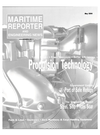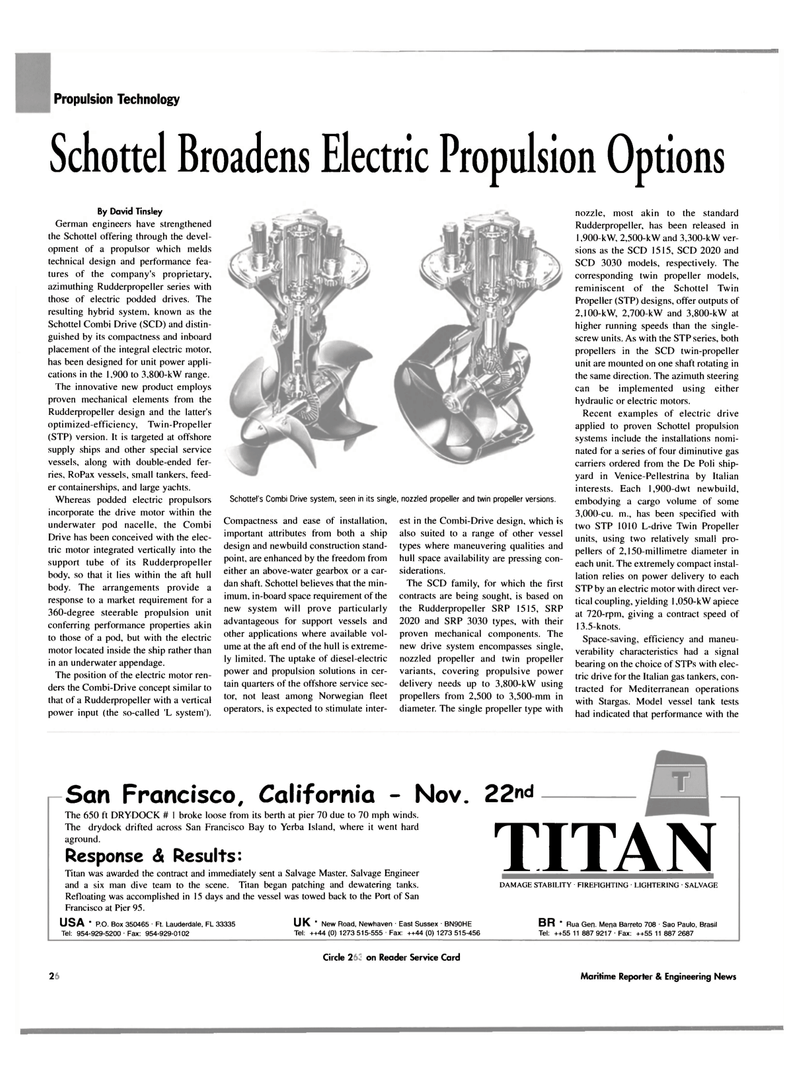
Page 30: of Maritime Reporter Magazine (May 2004)
The Propulsion Technology Yearbook
Read this page in Pdf, Flash or Html5 edition of May 2004 Maritime Reporter Magazine
Propulsion Technology
Schottel Broadens Electric Propulsion Options
By David Tinsley
German engineers have strengthened the Schottel offering through the devel- opment of a propulsor which melds technical design and performance fea- tures of the company's proprietary, azimuthing Rudderpropeller series with those of electric podded drives. The resulting hybrid system, known as the
Schottel Combi Drive (SCD) and distin- guished by its compactness and inboard placement of the integral electric motor, has been designed for unit power appli- cations in the 1,900 to 3,800-kW range.
The innovative new product employs proven mechanical elements from the
Rudderpropeller design and the latter's optimized-efficiency, Twin-Propeller (STP) version. It is targeted at offshore supply ships and other special service vessels, along with double-ended fer- ries, RoPax vessels, small tankers, feed- er containerships, and large yachts.
Whereas podded electric propulsors incorporate the drive motor within the underwater pod nacelle, the Combi
Drive has been conceived with the elec- tric motor integrated vertically into the support tube of its Rudderpropeller body, so that it lies within the aft hull body. The arrangements provide a response to a market requirement for a 360-degree steerable propulsion unit conferring performance properties akin to those of a pod, but with the electric motor located inside the ship rather than in an underwater appendage.
The position of the electric motor ren- ders the Combi-Drive concept similar to that of a Rudderpropeller with a vertical power input (the so-called 'L system').
Schottel's Combi Drive system, seen in its single, nozzled propeller and twin propeller versions.
Compactness and ease of installation, important attributes from both a ship design and newbuild construction stand- point, are enhanced by the freedom from either an above-water gearbox or a car- dan shaft. Schottel believes that the min- imum, in-board space requirement of the new system will prove particularly advantageous for support vessels and other applications where available vol- ume at the aft end of the hull is extreme- ly limited. The uptake of diesel-electric power and propulsion solutions in cer- tain quarters of the offshore service sec- tor, not least among Norwegian fleet operators, is expected to stimulate inter- est in the Combi-Drive design, which is also suited to a range of other vessel types where maneuvering qualities and hull space availability are pressing con- siderations.
The SCD family, for which the first contracts are being sought, is based on the Rudderpropeller SRP 1515, SRP 2020 and SRP 3030 types, with their proven mechanical components. The new drive system encompasses single, nozzled propeller and twin propeller variants, covering propulsive power delivery needs up to 3,800-kW using propellers from 2,500 to 3,500-mm in diameter. The single propeller type with nozzle, most akin to the standard
Rudderpropeller, has been released in 1,900-kW, 2,500-kW and 3,300-kW ver- sions as the SCD 1515, SCD 2020 and
SCD 3030 models, respectively. The corresponding twin propeller models, reminiscent of the Schottel Twin
Propeller (STP) designs, offer outputs of 2,100-kW, 2,700-kW and 3,800-kW at higher running speeds than the single- screw units. As with the STP series, both propellers in the SCD twin-propeller unit are mounted on one shaft rotating in the same direction. The azimuth steering can be implemented using either hydraulic or electric motors.
Recent examples of electric drive applied to proven Schottel propulsion systems include the installations nomi- nated for a series of four diminutive gas carriers ordered from the De Poli ship- yard in Venice-Pellestrina by Italian interests. Each 1,900-dwt newbuild, embodying a cargo volume of some 3,00()-cu. m., has been specified with two STP 1010 L-drive Twin Propeller units, using two relatively small pro- pellers of 2,150-millimetre diameter in each unit. The extremely compact instal- lation relies on power delivery to each
STP by an electric motor with direct ver- tical coupling, yielding 1,050-kW apiece at 720-rpm, giving a contract speed of 13.5-knots.
Space-saving, efficiency and maneu- verability characteristics had a signal bearing on the choice of STPs with elec- tric drive for the Italian gas tankers, con- tracted for Mediterranean operations with Stargas. Model vessel tank tests had indicated that performance with the
San Francisco, California - Nov. 22nd
The 650 ft DRYDOCK # 1 broke loose from its berth at pier 70 due to 70 mph winds.
The drydock drifted across San Francisco Bay to Yerba Island, where it went hard aground.
Response <& Results:
Titan was awarded the contract and immediately sent a Salvage Master, Salvage Engineer and a six man dive team to the scene. Titan began patching and dewatering tanks.
Refloating was accomplished in 15 days and the vessel was towed back to the Port of San
Francisco at Pier 95.
USA • P.O. Box 350465 Ft. Lauderdale, FL 33335
Tel: 954-929-5200 • Fax: 954-929-0102
UK ' New Road, Newhaven • East Sussex • BN90HE
Tel: ++44 (0) 1273 515-555 • Fax: ++44(0) 1273 515-456
TITAN
DAMAGE STABILITY FIREFIGHT1NG • LIGHTERING • SALVAGE
BR • Rua Gen. Mena Barreto 708 • Sao Paulo, Brasil
Tel: ++55 11 887 9217 Fax: ++55 11 887 2687 32
Circle 229 on Reader Service Card
Maritime Reporter & Engineering News

 29
29

 31
31
